I finally made my pilgrimage to the Dehillerin store in Paris.
I wanted to apply a curious and critical eye to the copper cookware available on-site. My impression is that the bulk of Dehillerin’s retail sales are now conducted via their website, and that they maintain the storefront largely as a tourist attraction. But I have also heard that the store has a few vintage gems on the shelves, such as super-thick Mauviel from the second golden age (1970s-early 2000s).
My key question: Does Dehillerin have a secret trove of Mauviel copper that is no longer made or that is not available online?
I took a quick spin through Dehillerin’s website to assess what Mauviel copper they offer for sale as of early 2023. They offer certain pieces of tinned copper at 1.5mm thickness and (circa) 2.5mm, as well as some bimetal (copper lined with steel) at 1.5mm, 2.0mm, and 2.5mm. (Dehillerin still uses Mauviel’s term Cuprinox for bimetal pieces though since the 2000s Mauviel calls these pieces M’héritage.) This is greater variety than you’ll find at Williams-Sonoma but equivalent to specialty cookware retailers such as France Corner or Sukalde.
With the above information in mind, let’s take a look at Dehillerin’s store windows and shelves (as they appeared in late summer 2022) to see whether there are items on display beyond what’s available from the retail website.
Store windows
This is the primary copper display window with an appealing variety of copper pieces ranging from small saucepans to large stockpots and cocottes, with a few specialty items thrown in. (Apologies for the window reflections that make it hard to see some details.)

It looks to me like this display window hasn’t been touched for some time. Many of the pieces are out of production or featuring old handle designs. (I’m using my own terminology for the handle styles — I’m not aware of official names for them. At the end of this post I have a brief explainer with photos.)
- I spy four pans with pre-2015 “classic teardrop” stick handles in cast iron hidden among the forest of brass: three steel-riveted (hence likely steel-lined Cuprinox) windsors hanging on the wall and an oval fish pan (also smooth sided and likely steel-lined, though if the rivets are copper, it’s tinned) hanging just above them. None of these are listed for sale on the Dehillerin site and Mauviel stopped making 3-rivet handles like this circa 2015 or so. Without looking at them for a post-2000s Mauviel stamp, my guess is that those windsors are 2010s-era extra fort and, with cast handles, likely 2.5mm and quite desirable for their thickness. I can’t find that oval fish pan in the catalogs, so it might be older than that, but I’d hazard a guess that with a cast-iron handle it’s extra fort as well.
- The oval gratins hanging just below the iron-handled windsors have the three-rivet classic D-style handle, which makes them pre-2015. With silvery rivets they are likely steel-lined table at 1.5mm. These are also not listed for sale on the website.
- The saucepans hanging just above and to the left of the iron-handled windsors have brass “classic keyhole” stick handles with polygonal baseplates and silvery rivets. The pieces are most likely vintage Cuprinox table at 1.5mm thickness. Mauviel hasn’t made these handles since at least the early 2010s and they are definitely not listed on the Dehillerin website, though they would be functionally identical to a new M’héritage 150b.
- The brass baseplates on several of the oval cocottes and stewpots are either plain ovals or the split style with no connecting plate between rivets. These are hard to date as these styles have been in use for decades and show up in Mauviel catalogs up to 2014. But the rivets are copper, which makes them tin-lined, and I don’t see them on the current Dehillerin website.
- One standout piece (at least for me) is the hammered tinned oval gratin with the fitted domed lid, set on a box in the foreground of the display window. These are beautiful and quite hard to find.
The other display windows are smaller and feature fewer copper items. Below is the famous Dehillerin copper and brass rooster (le coq n’est pas à vendre, “the rooster is not for sale”) accompanied by a footed bowl and a lovely fondue pot. Hanging at the right is a vintage iron-handled tinned saucepan with copper rivets, another item no longer for sale on the Dehillerin website.
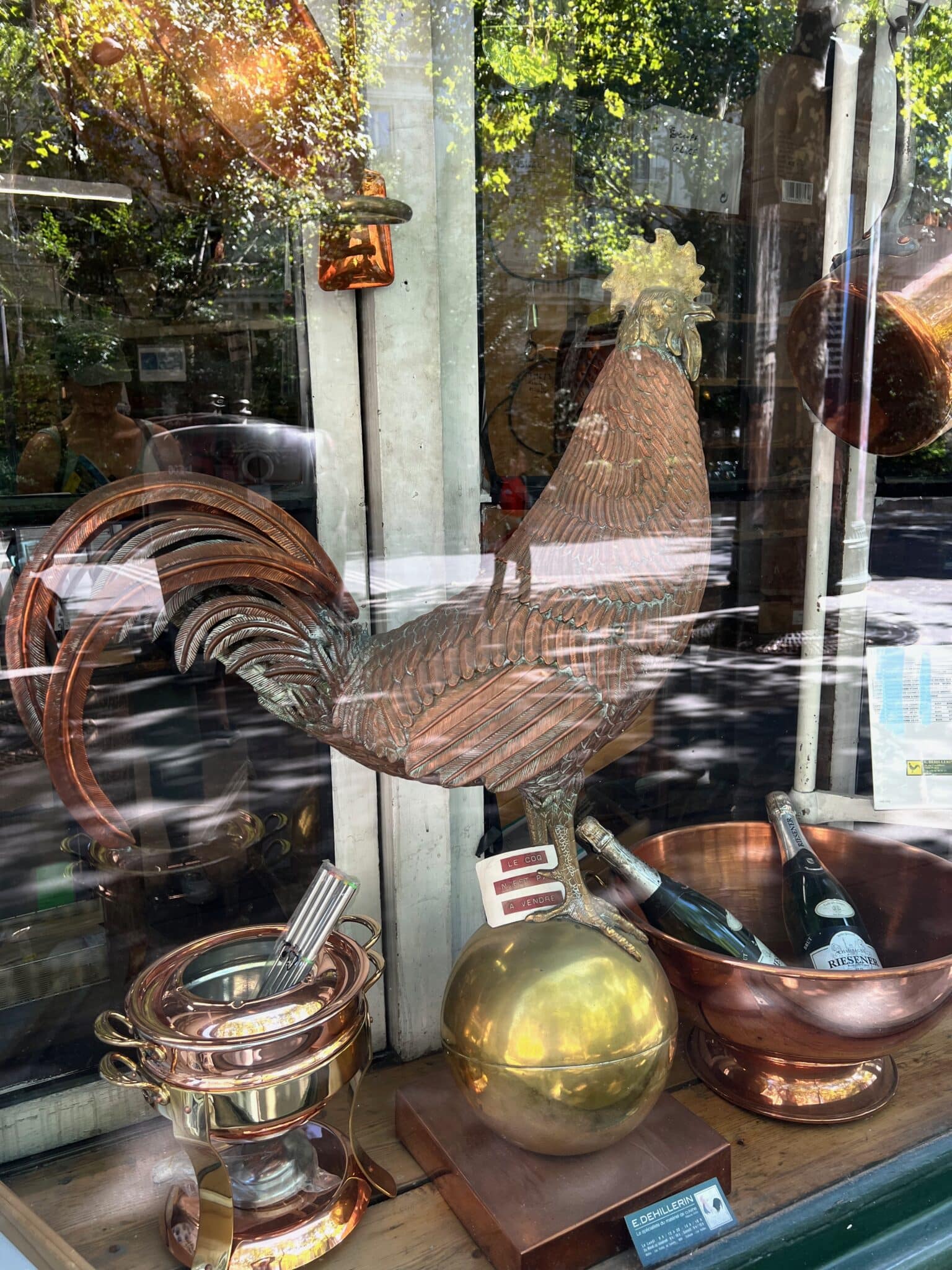
Here is a tempting array of copper molds. Sadly, ces moules ne sont pas à vendre — they’re from the Dehillerin family collection and not for sale. I wish I could check them for maker’s marks. I don’t think Dehillerin was manufacturing its own molds — I would bet these are Trottier or early Mora.
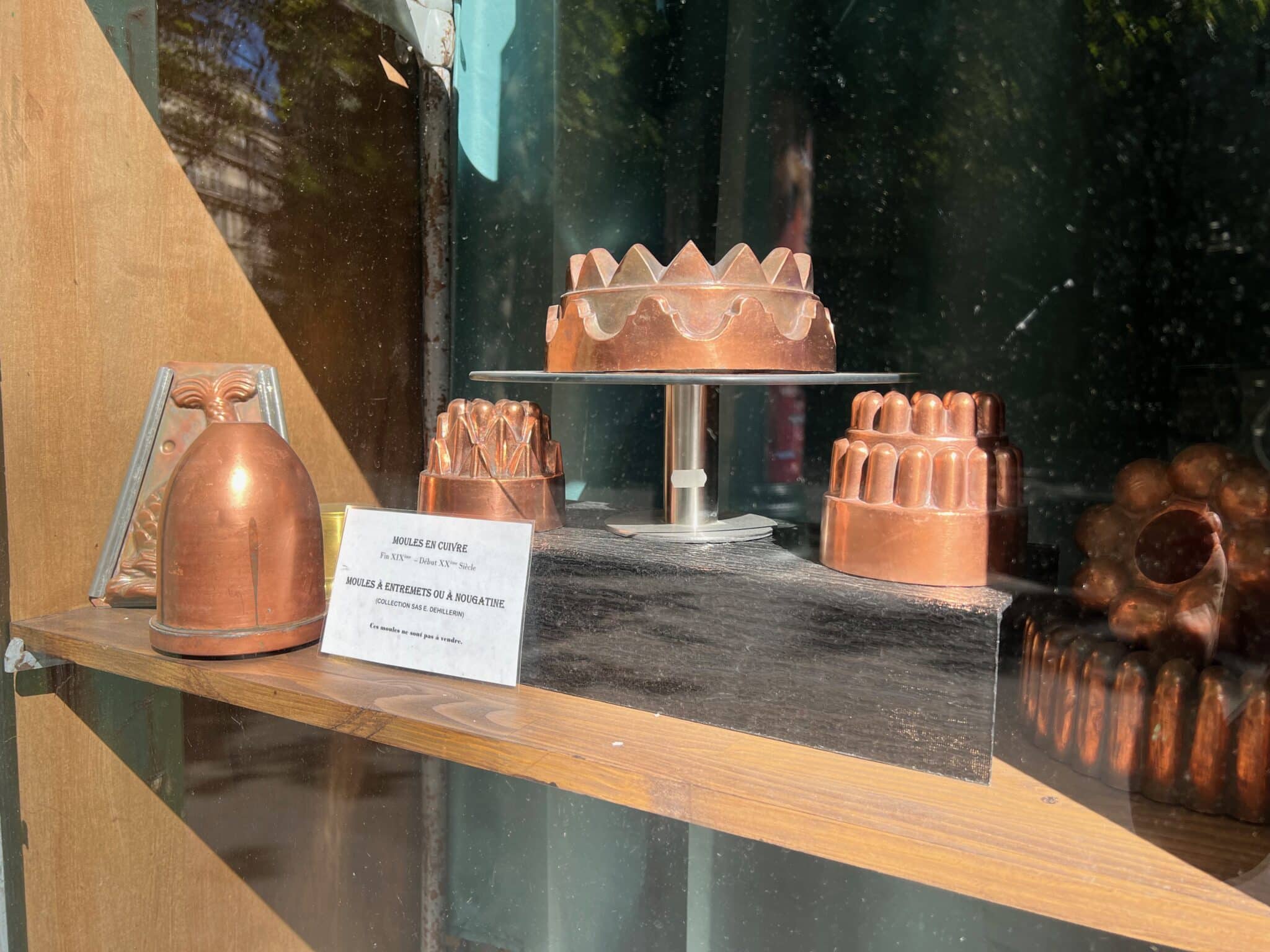
I could not resist taking a photo of duck presses available in brass or chrome finish in small or large size. I find these to be somehow charming and yet also gruesome.

Rez-de-chaussée
Now let’s venture inside.
Just inside the store entrance on the left is the famous display of copper. Anti-theft security chains and ropes are threaded through the hanging loops and handles of the more snatch-able pieces and an attentive storekeeper hovers just a few steps away.

In the foreground is an array of steel-lined Cuprinox with brass handles. I see three handle types in this cluster that suggest the era of the pans.
- I see the two-rivet M handle on the large steel-lined sauté pan, windsor (sauteuse évasée), and nested skillets on the left. The retail website lists M200 skillets so they could be 2mm; the sauté and windsor could be either M200 or M’héritage 250b. I’d have to weigh them (or ask the storekeeper for specifics) to be sure.
- I see two-rivet 1830 handles on the oval fish plates towards the right and, I suspect, on the largest of the plats ronds (round egg pans). The oval fish pans and plats ronds were only ever made in 1.5mm thickness, making them all M’héritage 150b.
- The nested sauté pans are a bit of a puzzle. I didn’t get a clear view of the largest saute (believe me, if I could go back and re-shoot for this post, I would) but with the two rivets and teardrop hanging loop I suspect it’s an M, making this either M’héritage 150b or 250b from 2015-2016. The smaller sautés within it have keyhole hanging loops so they’re likely classic keyholes, making them most likely M’héritage table pre-2015, or, if they’re pre-2000, Cuprinox table.


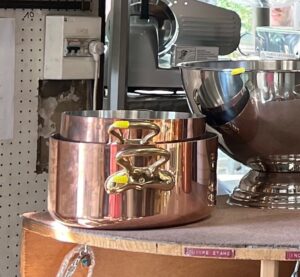 The curved shelf just above has two steel-lined stewpots on the left and a hammered tin-lined champagne bucket on the right.
The curved shelf just above has two steel-lined stewpots on the left and a hammered tin-lined champagne bucket on the right.
Notably, the outer stewpot has the classic three-rivet Mauviel handle from the pre-2014 era. If that stewpot is extra fort — 2.5mm — that would make it a desirable piece in my opinion. I can’t quite make out the inventory number on the yellow labels and I wish it had occurred to me in the moment to check their grade. (I was trying to be discreet and efficient with my photography — the attendant had the long-suffering demeanor of a Frenchman forced to endure every variety of rude and bizarre behavior from a relentless stream of American tourists, and I felt in the moment that hauling these pieces apart and demanding access to a pair of calipers would stretch his tolerance beyond the breaking point.)
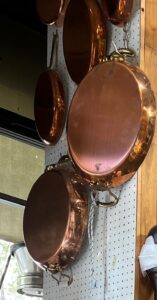 Hanging from the narrow pegboard above the stewpots is a grouping of round gratins and fish pans.
Hanging from the narrow pegboard above the stewpots is a grouping of round gratins and fish pans.
I’m pretty sure the fish pans are steel-lined but I’d have to see their baseplates to determine whether they’re recent era or older production. Oval pans with end-mounted handles like these require a narrow handle baseplate; Mauviel’s current design has a petite two-rivet baseplate and a keyhole-shape hanging loop. If the baseplate is polygonal with three rivets, then the pan is 2000s-era production; if the baseplate is a smooth oval with two rivets, then it’s recent production.
The round gratins look to my eye to have two-rivet 1830 baseplates, steel rivets, and smooth sidewalls. The Dehillerin website lists plats ronds up to 20cm, but these are too big for that — they could be paella pans, but Dehillerin lists only one at 35cm diameter. My guess is that these are older M’héritage 150b but they could be 250b.
Continuing along the copper display area, there is a large expanse of pegboard above three tiers of shelves. There is a lot going on here so let’s take our time to look, starting with the three sets of hanging saucepans.
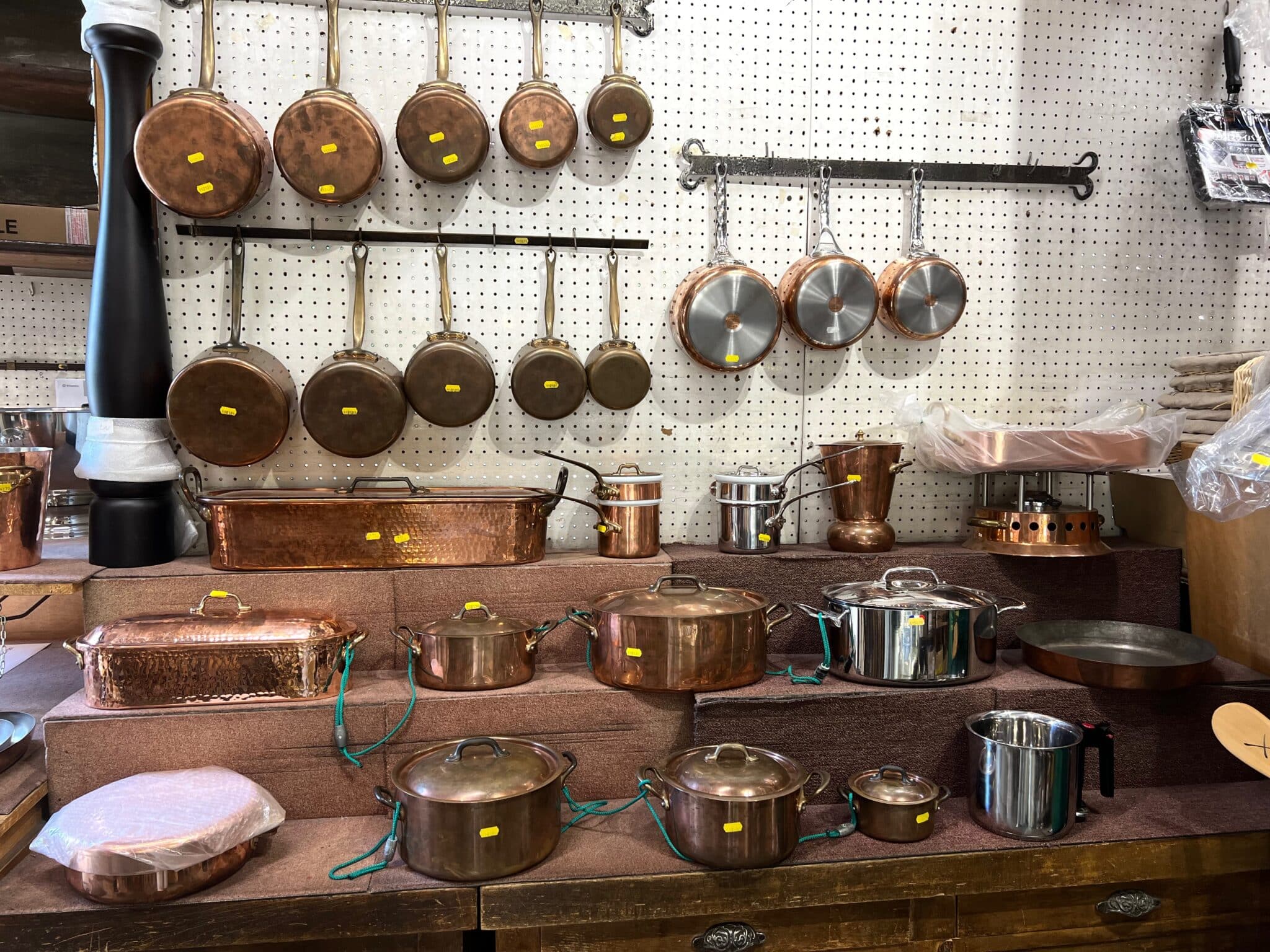
I assess that the hanging saucepans are tinned and steel-lined models from the 1980s to the present day.
The upper rank of saucepans looks like a set of “CASSEROLE CUIVRE ÉTAMÉ EXTRA FORT QUEUE BRONZE” available on the website from 12cm to 24cm.
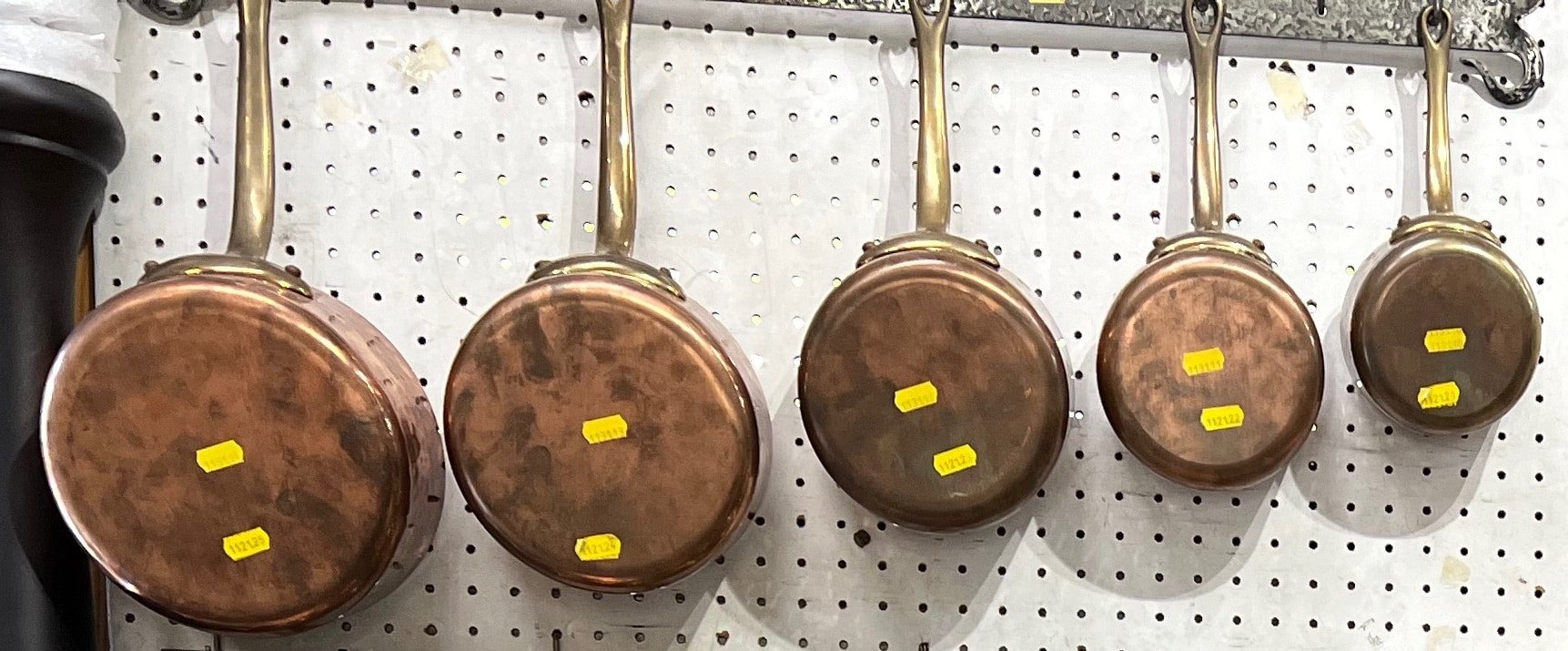
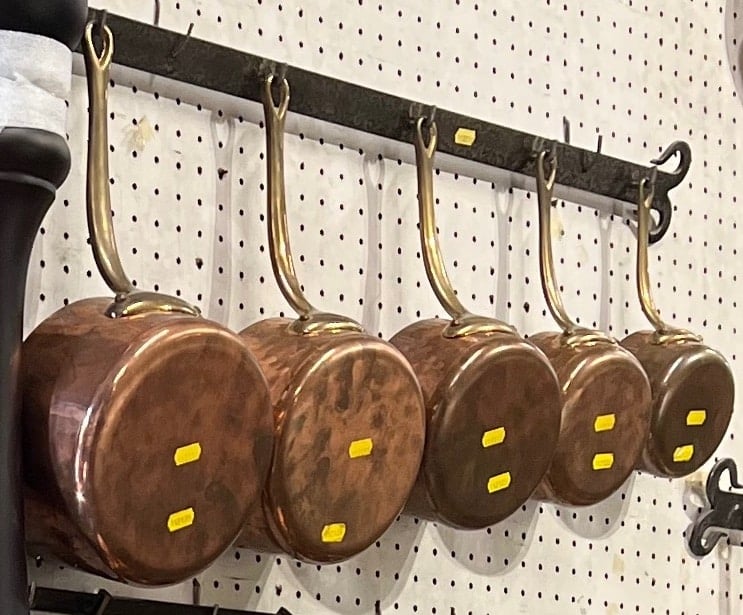
The lower rank of pots are steel-lined — the sidewalls are mirror-smooth and the rivets have the silvery color of steel. And again we see baseplate differences across the array. The largest pot hanging on the far left has the three-rivet polygonal baseplate that I call “classic keyhole” that we’ve seen a couple of places already, and which I believe is 1980s-2000s era production. The other four pots have the two-rivet 1830 baseplate design and “110” series stock numbers that mark them as Cuprinox table — Dehillerin’s notation for steel-lined copper at 1.5mm thickness.
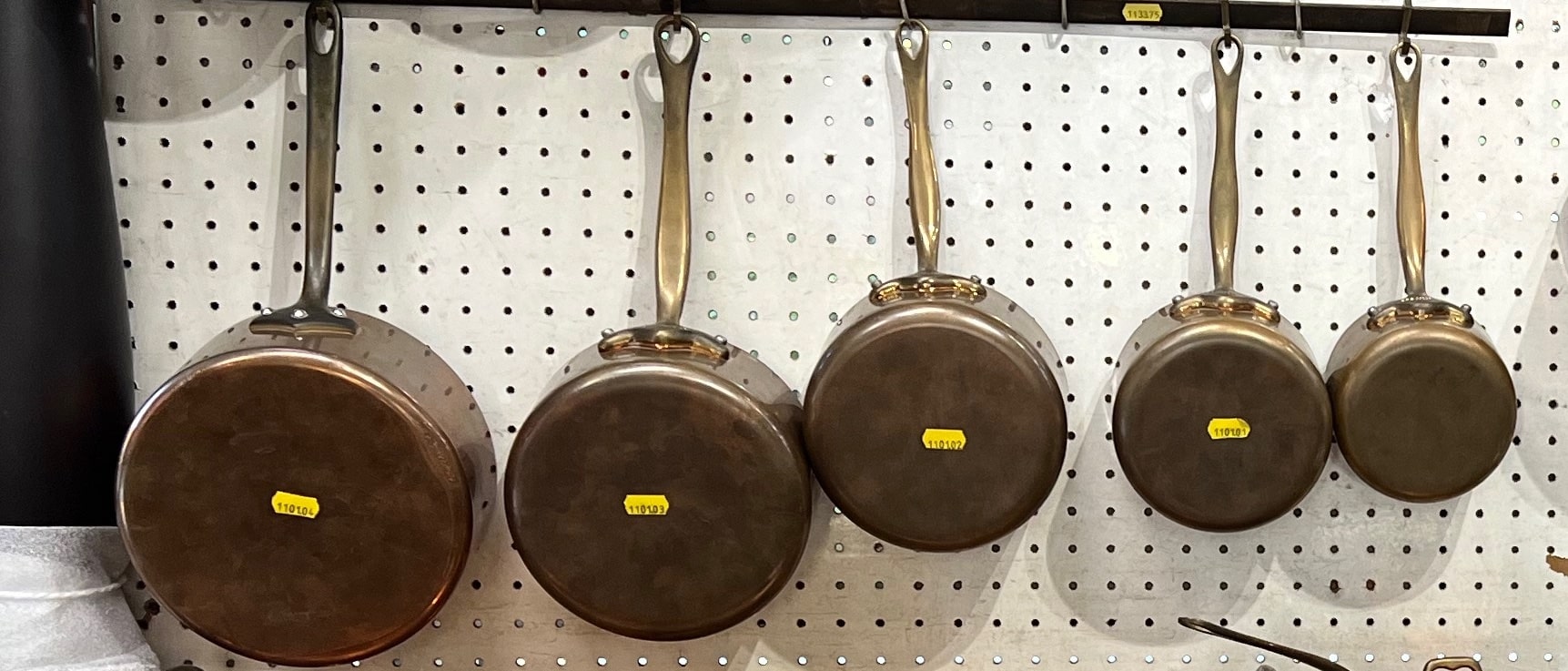
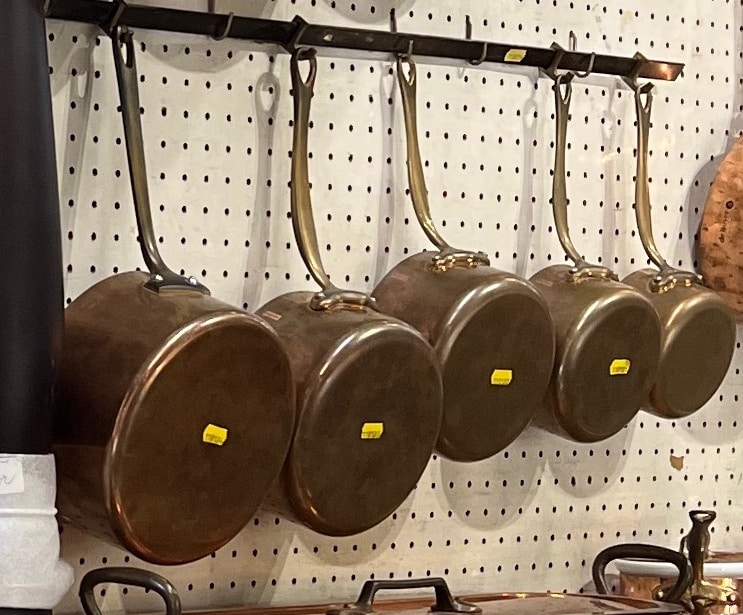
 To the right, the three saucepans with silver-colored bases hanging from a rack are not Mauviel make. Instead, I believe they are De Buyer’s Inocuivre line — steel-lined copper pans with a steel layer bonded to the base to make them compatible with magnetic induction burners.
To the right, the three saucepans with silver-colored bases hanging from a rack are not Mauviel make. Instead, I believe they are De Buyer’s Inocuivre line — steel-lined copper pans with a steel layer bonded to the base to make them compatible with magnetic induction burners.
Below is a three-tiered shelf with an array of larger pots and pans.
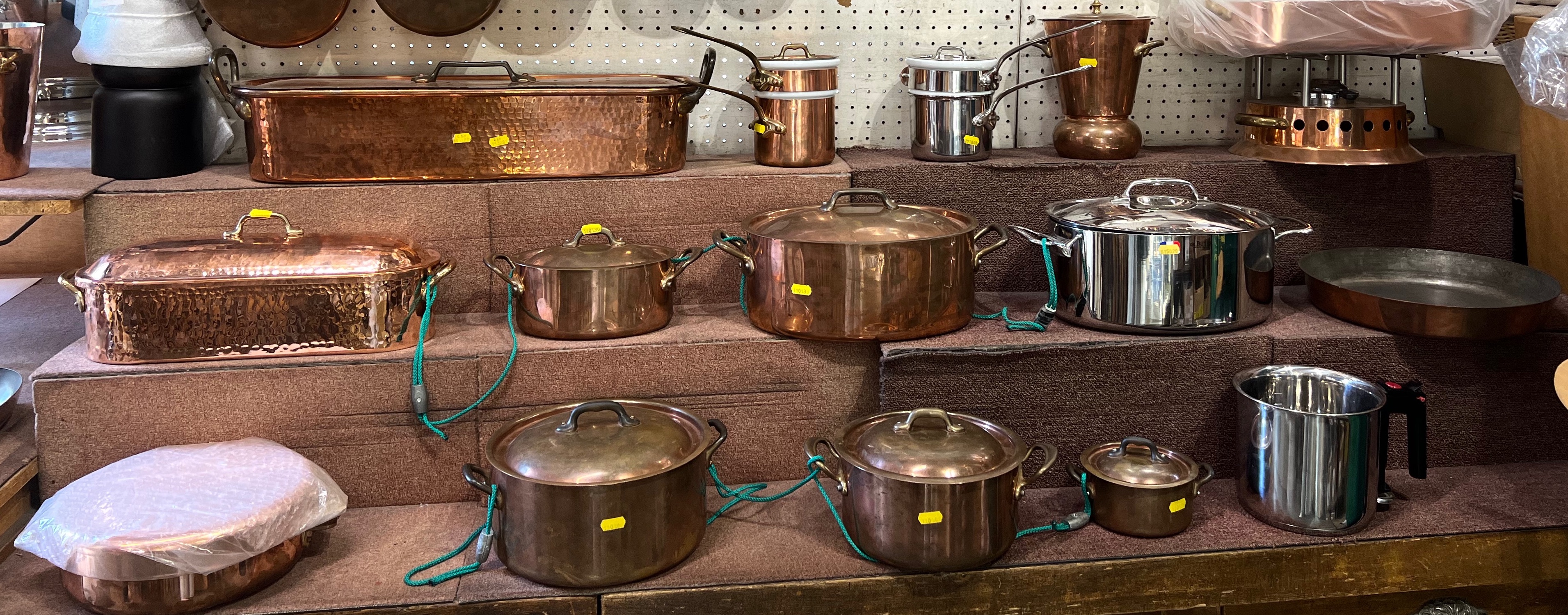
On the top tier are a poissonière, two bains maries, a marmite pomme vapeur conique (potato steamer), and a chafing dish. (Not sure the chafing dish is Mauviel!) All of these, with the exception of the chafing dish, appear on the Dehillerin website.
The middle tier has a poissonière à truite, three oval cocottes, and what looks like a tinned tarte tatin pan. All of these are on the website. Notably, the two copper cocottes look to have different handles: the smaller one on the left has what looks like a two-rivet M or 1830 handle, while the larger one has three rivets and could be pre-2015. I believe they’re both steel-lined Cuprinox table at 1.5mm, functionally equivalent to what you can buy from Dehillerin now.
Finally, the bottom row, left to right, are a pommes Anna, three round cocottes, and something in stainless steel. The pommes Anna looks like smooth-sided recent production — a pity they stopped hammer-finishing them! The cocottes are likely all 1.5mm Cuprinox table, though once again they have different handle styles. I believe the smallest and largest have split baseplates while the medium sized one has either an M or 1830 baseplate. These aren’t functional differences, of course.
Above the pans are a collection of pieces hanging on hooks up to the ceiling level. In addition to an assortment of bowls, zabaglione pans, utensils, molds, and a couple more De Buyer Inocuivre, there are a few more copper cookware pieces. And once again I see a mix of handle styles that suggest a range of ages for the pieces shown.
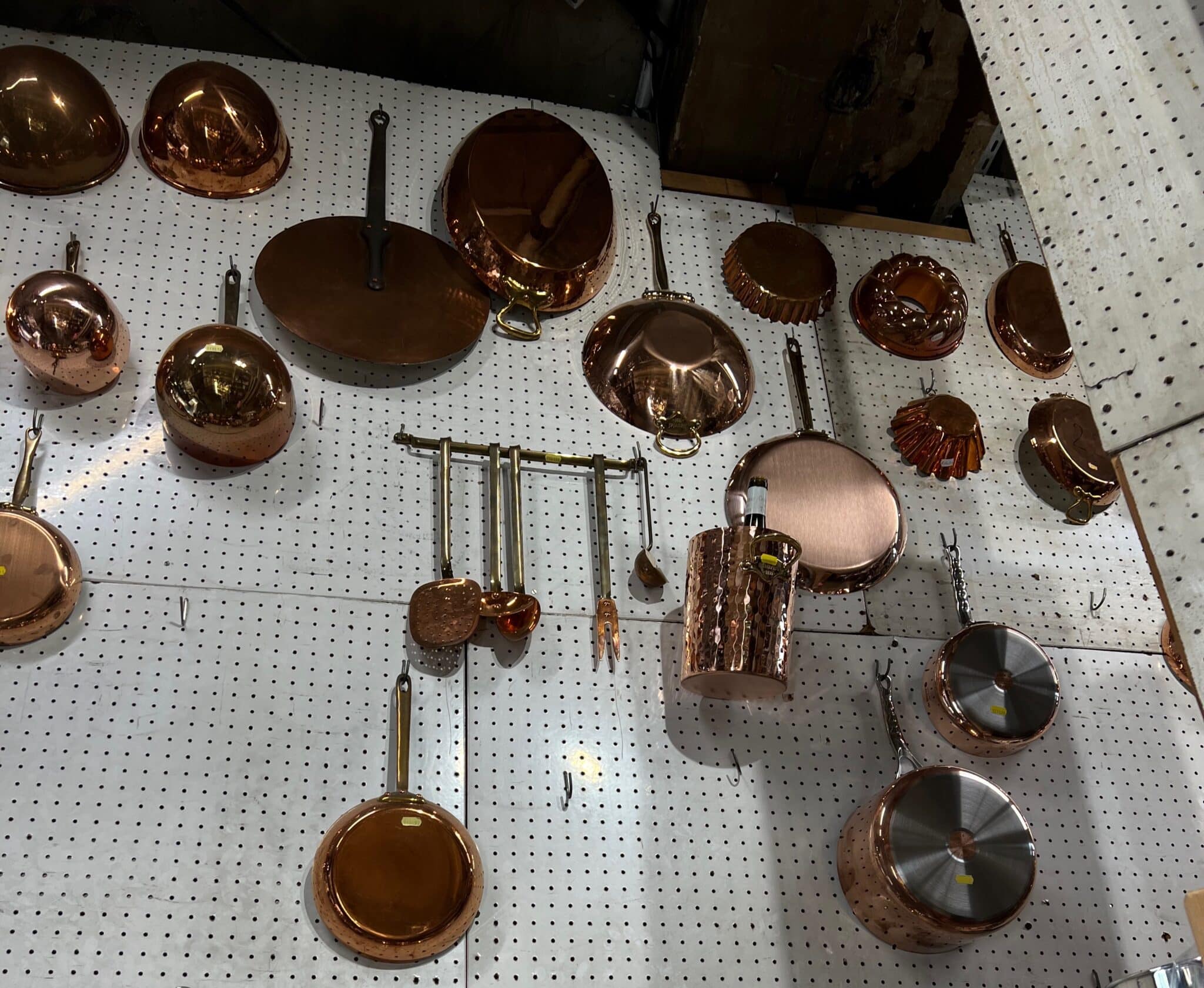
There are three skillets in the photo and I think they’re all different.
- The small skillet on the left (partially cut off in the photos, sorry about that) has the recent-era second-generation 1830 handle style. Even if you can’t see the lobed shape of the baseplate, the tapered shape of the handle shaft gives it away. This is steel-lined, post-2015, likely M’150b, the same as the skillet on the Dehillerin website.
- The lowest-hung one towards the center has a brass handle, rounded baseplate, three copper rivets, and a keyhole loop. The copper rivets indicate that it’s tinned, making it another item on display that’s not available on the website. My guess is that this is 2000s-era M’tradition 150b.
- The largest of the skillets, hanging towards the upper right in the photo with a brushed-finish base, has the narrow-base version of the M handle with its keyhole loop (as opposed to the teardrop-loop 1830 handle). It’s steel-lined. I suspect this is a few years old (maybe mid-2010s) and functionally identical to new stock.
There are two gratins.
- If my eyes do not deceive me, the large oval gratin has a hammered surface and copper rivets, which suggests it’s tinned and possibly extra fort thickness. It has the classic three-rivet pre-2015 handle on it as well. That’s potentially quite a nice piece.
- The smaller round gratin to the far right in the photo could be tinned as well — the handle is in the classic style and the rivets look like copper to me. I’d have to see the interior in order to be sure. With its smooth sides it’s likely table-grade 1.5mm copper.
Other notable items in the photo are the wok and the pretty champagne bucket. They both have the second-generation modern (post-2017 or so) Mauviel 1830 handle.
That does it for the pieces I can speak to in the main display! Elsewhere in the store is a second copper wall.

The way those fish pans are hung and the angle of the photo makes it impossible to see much of the handle baseplates, but even so we can make a few observations. Scan across the hanging loops of those fish pans and you will see a mix of straight-contour handles with keyhole hanging loops and tapered-contour handles with teardrop shapes.
- The keyhole loops are brass-handled steel-lined pieces, likely 1.5mm table M’héritage 150b.
- The teardrop loops are tinned pieces with cast iron handles. The rivets are copper and the sidewalls of the pans look hammered. They appear to have two rivets only, but the lower edge of the baseplate is smooth and does not have the lobed look of the 1830 style. I’m not quite sure how to date these, but they likely predate the 2015 handle redesign and could be 2000s era or even earlier.
- The round gratins — plats ronds, as Mauviel calls them — have three-rivet classic-style brass handles, smooth sidewalls, and silvery colored rivets. I believe these are also steel-lined 1.5mm pre-2015 M’héritage production.
The three pots at the lowest tier with silvery bases are more induction-ready pieces that I believe are De Buyer.
That covers the copper I saw on display on the main floor of the store. Next: the basement!
Sous-sol
Down twin curved staircases is the basement with long shelves that serves as a storeroom. Let’s see what delights await us! (Yes, I went down the Sortie side by mistake.)
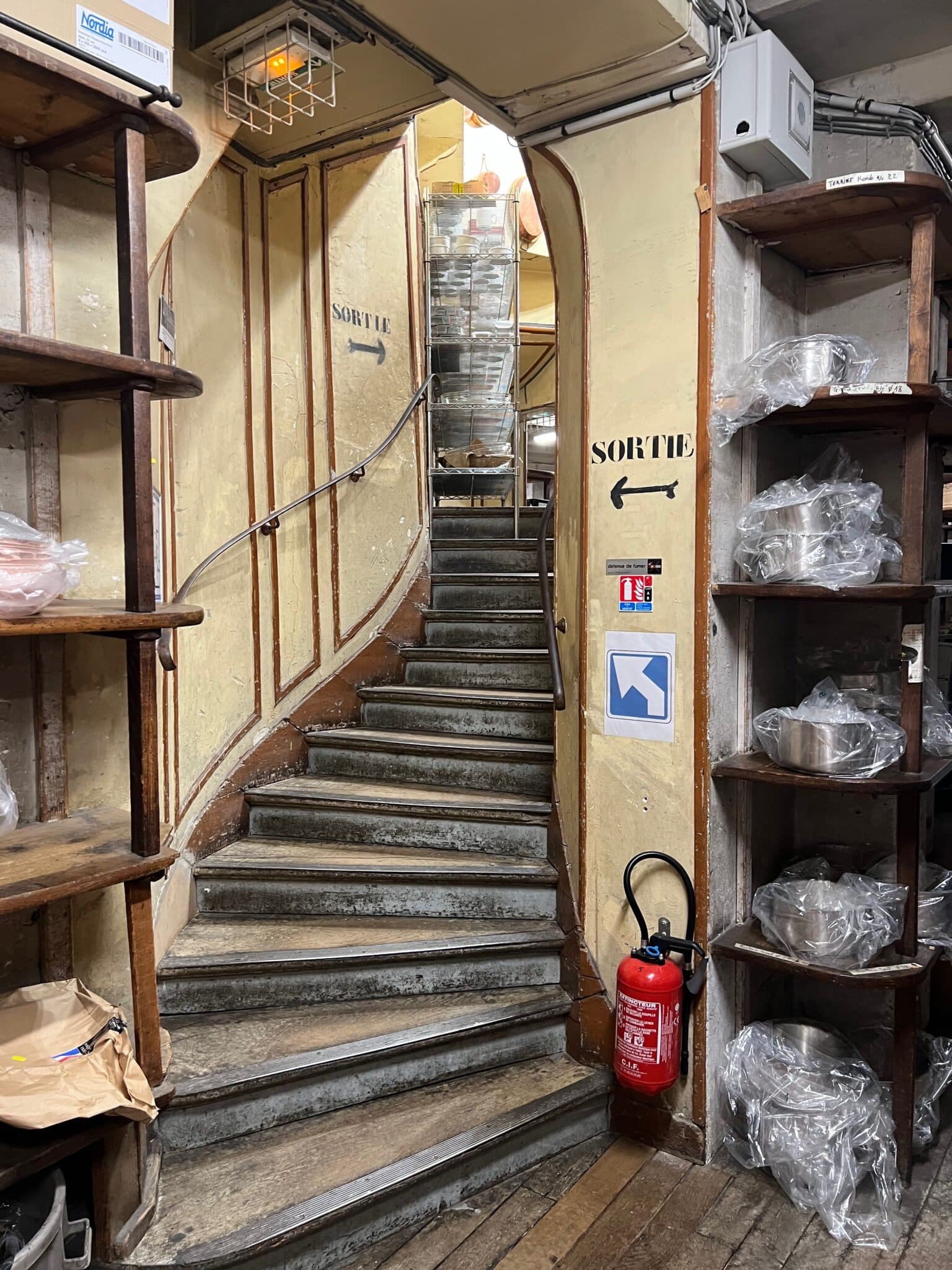
The two photos below are two halves of the same long wall — this gives you an idea of how much space there is in the stockroom. I was surprised at how bare the shelves are. It looks as though Dehillerin keeps one or two representative pieces on hand. Pieces are wrapped in plastic and, as is the case upstairs, many of them are secured with anti-theft ropes.

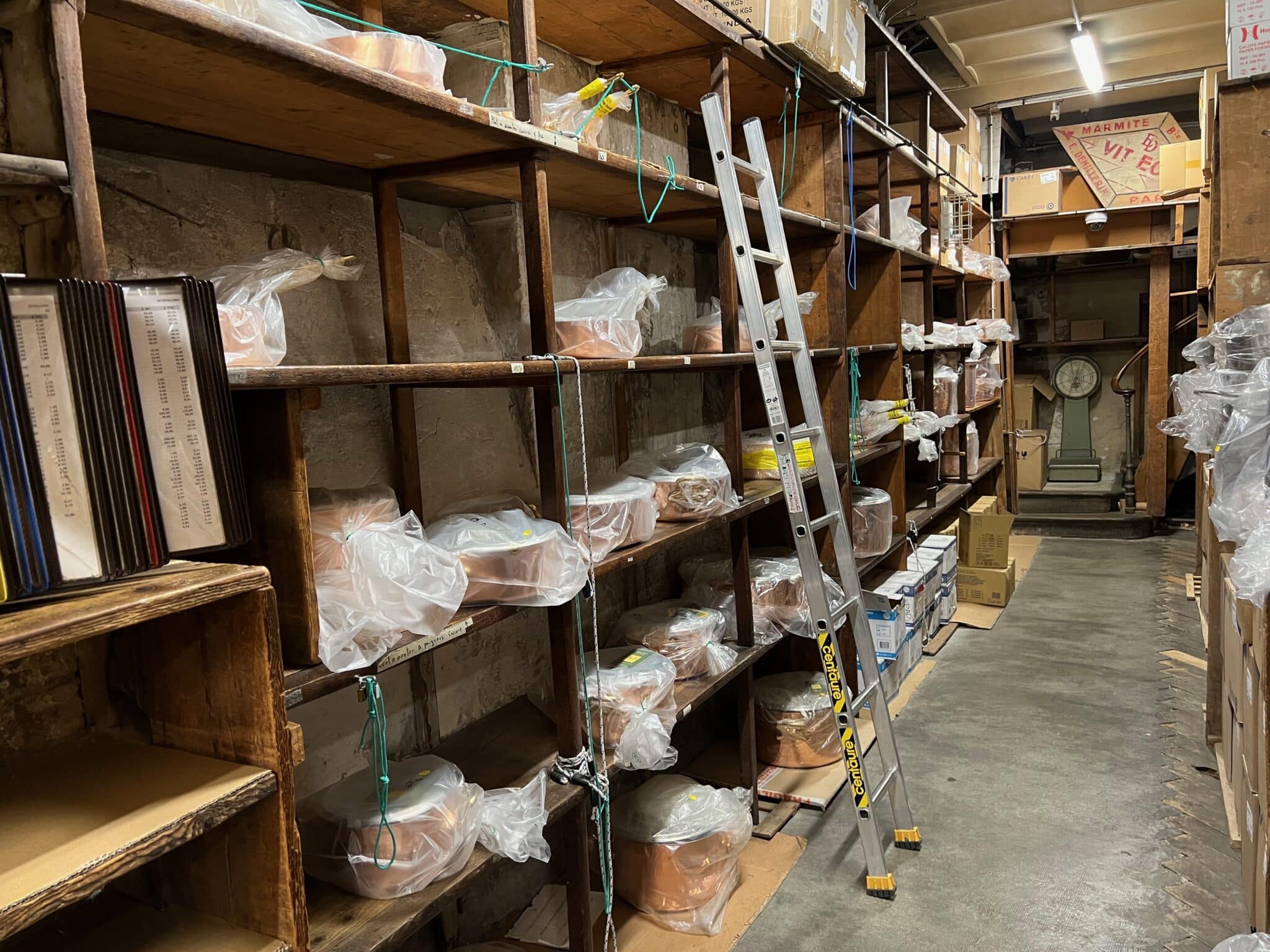
Let’s begin with the saucepan section.
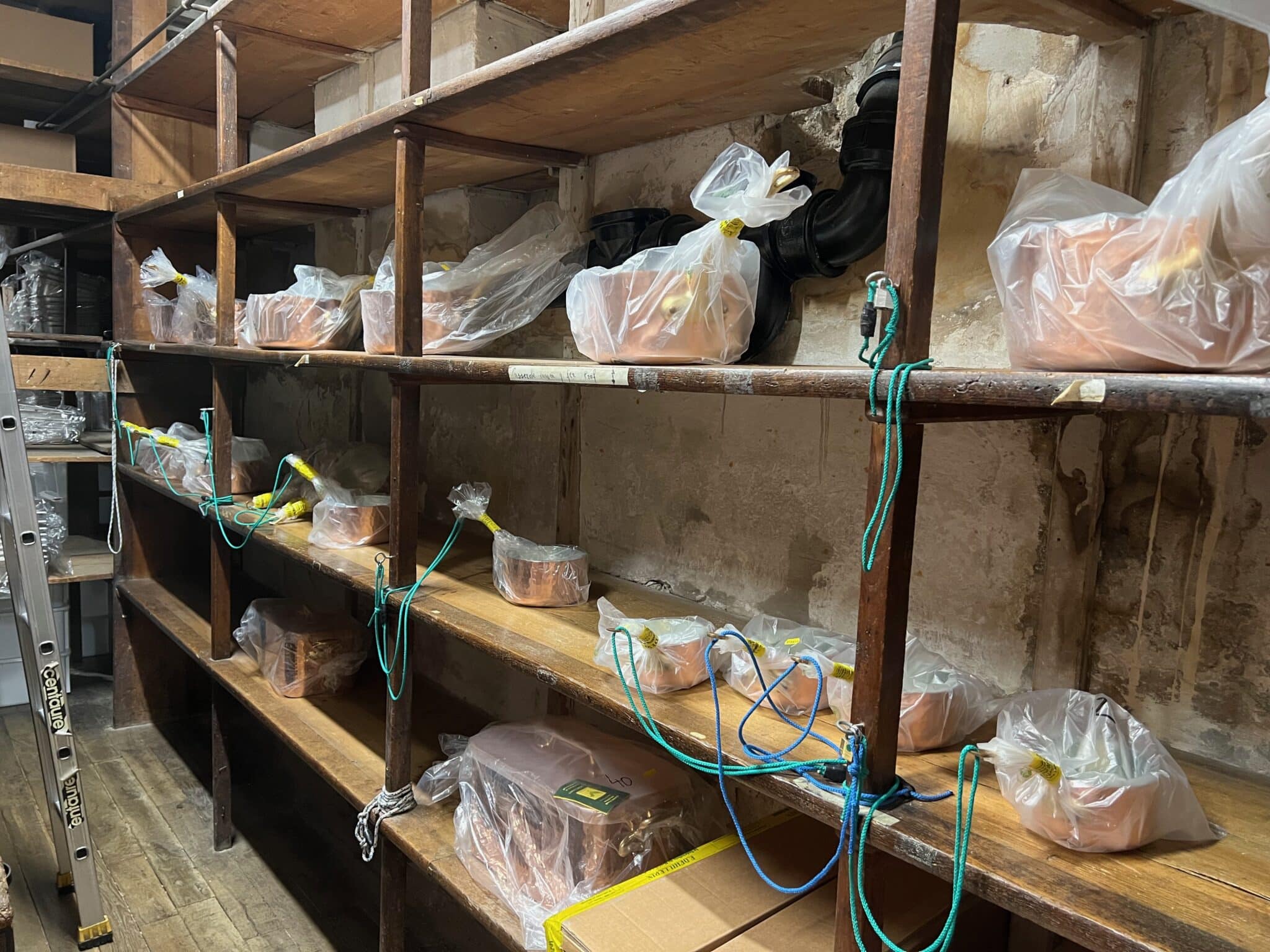
The shelves exhibit a range of hammered-finish tinned and smooth-walled steel-lined pieces. The top two shelves are saucepans, and the bottom shelf has two tinned daubières, a 32cm and a 40 cm. (The website also lists a 36cm size.)
Below is a nice close-up of a tinned saucepan with the two-rivet M handle. Note also the current version of Mauviel stamp reading “MAUVIEL 1830 Made In France.” This piece and others like it are recent production available from the Dehillerin site.

The other half of that long stockroom wall has a section of sauté pans, rondeaux, and stewpots. They all look to be bagged current production pieces.

Just beyond the steel ladder in the photo above are some nice pieces, like this 36cm tin-lined hammered rondeau.

Just below it is this 45cm rondeau.

Further along that same wall, towards the far corner, are more pieces.
On the top shelf, two copper bowls with pre-2015 brass handles. The second shelf has sugar pots bearing the “MAUVIEL 1830” brand stamp. The third shelf has two hammered (tinned) stockpots with current M style handles. The bottom shelf holds an oval two-bottle wine cooler with current M style handles.

The free-standing shelf units running down the middle of the stockroom don’t have any copper on them, but there is one more copper zone in the corner.

Two 60cm poissonnières, ready to go.

A turbotière, waiting for a walk-in customer, I suppose!

Quite a few jam pans, all jammed together. Heh.
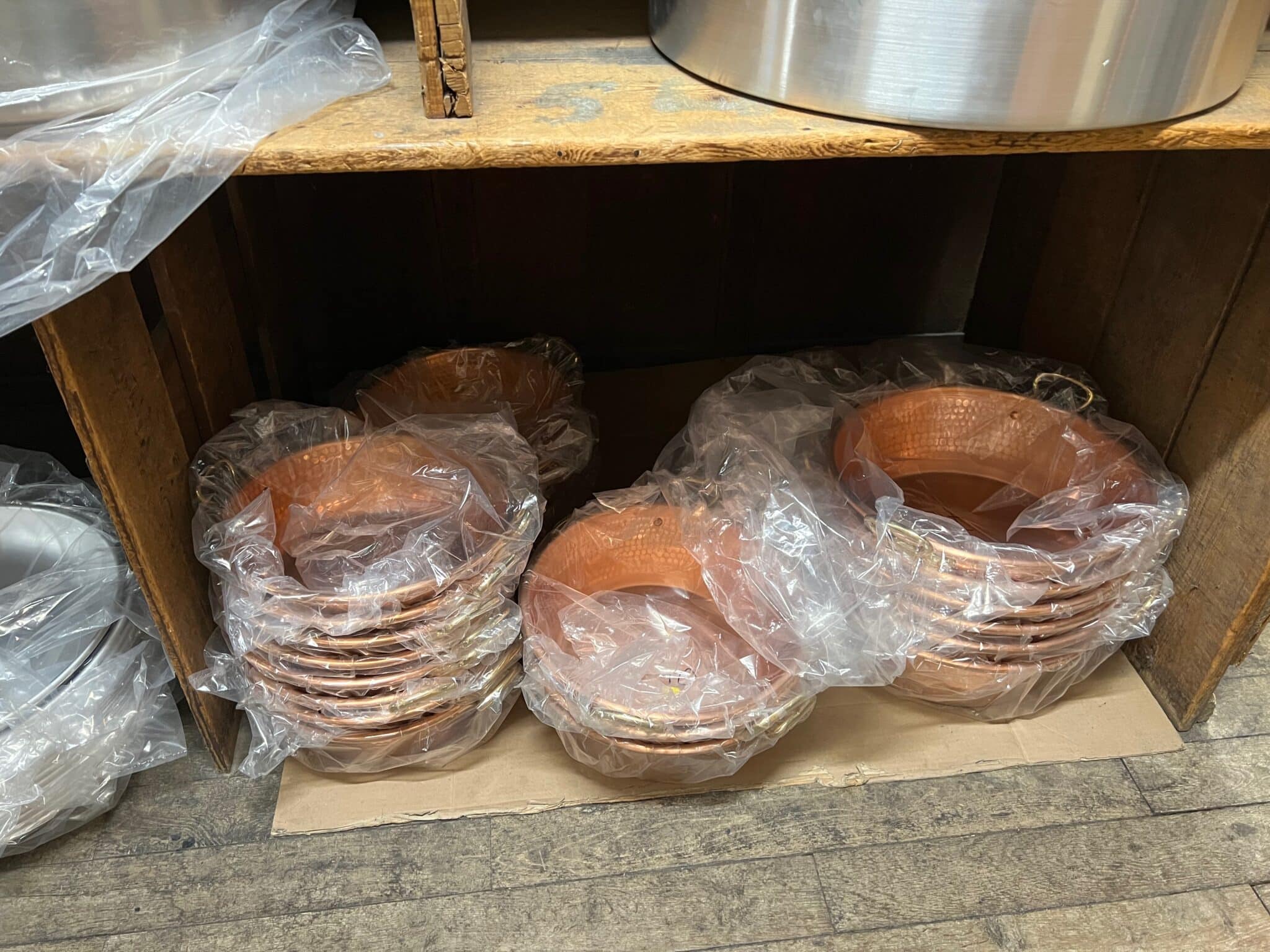
And this food mill. It’s not copper, obviously, but I am fascinated by it. I am sure several readers have and use a food mill, but this is a new and exotic object for me. This is a restaurant-grade food mill, standing about 2 feet high, with a tripod so a large bowl can fit underneath.
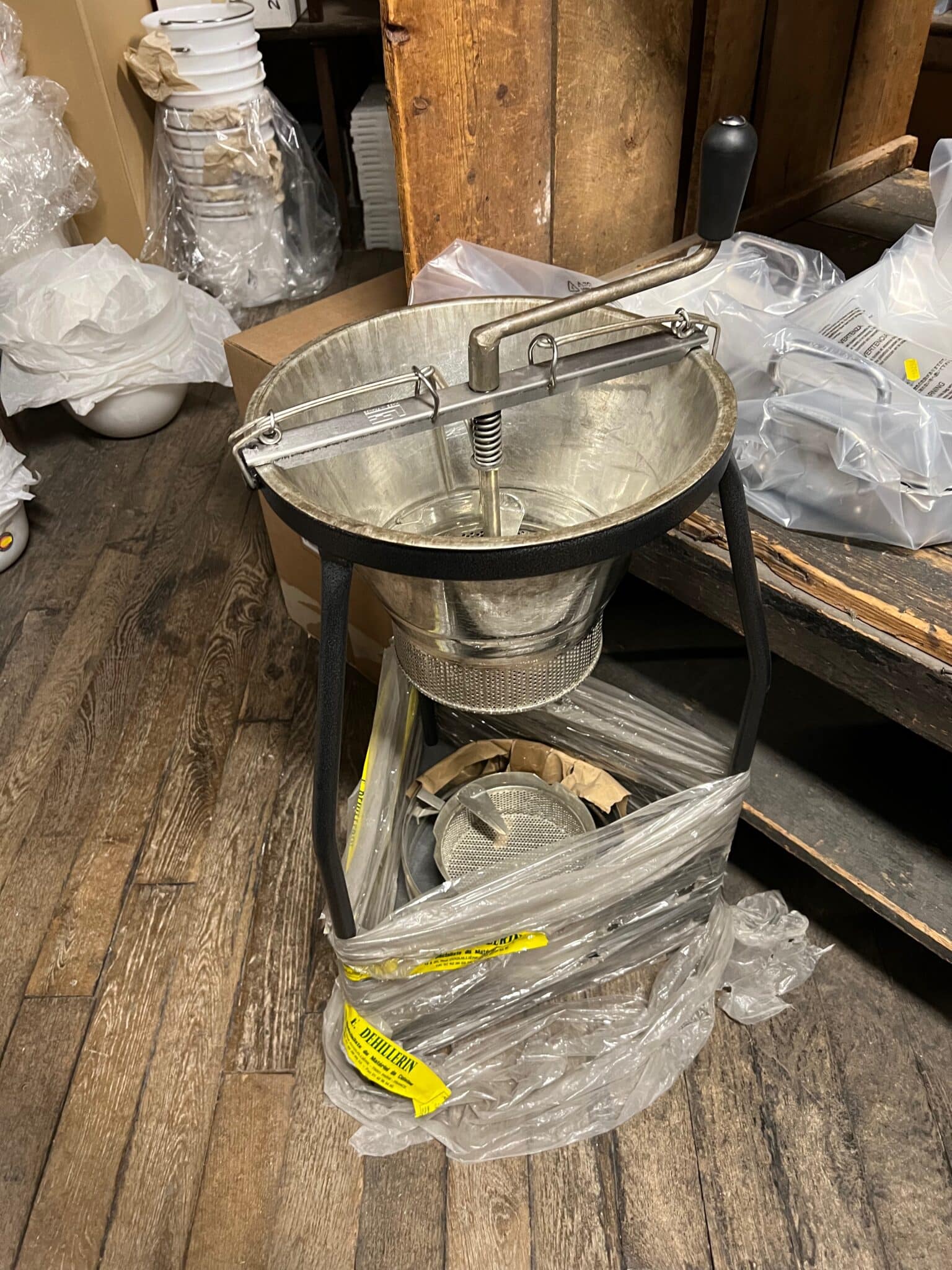
That’s about it for the stockroom area! Except for one more thing…
The secret chamber
Tucked into the space between the twin staircases is a cramped niche with a forbidding (if somewhat flimsy) gate. The paper warning sheet reads ENTRÉE INTERDITE À TOUTE PERSONNE ÉTRANGER AU SERVICE (“entry forbidden to non-employees”) and the lettering on the wooden pickets reads REÉTAMAGE ENTRÉE INTERDITE (“retinning, no entry”).

This appears to be a holding area for a customer-owned pots and pans for retinning, as well as various other odds and ends. The photos below show the left and right niches under the steps.

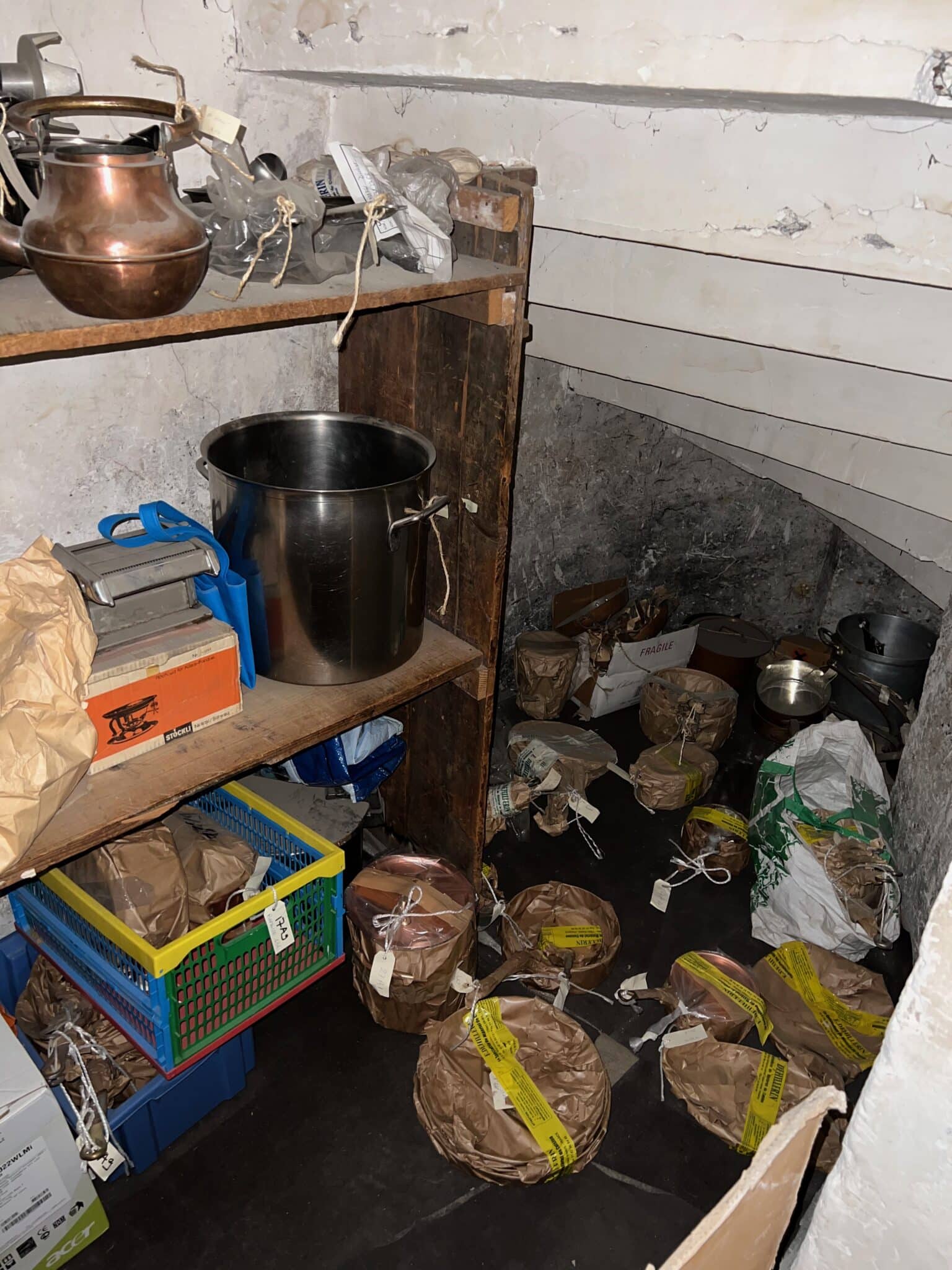
What a cave of treasures! I wonder who does this retinning work?
Conclusion
Let’s return to my question from the start of the post:
Does Dehillerin have a secret trove of Mauviel copper that is no longer made or not available at other retailers?
My answer: Not really.
- Dehillerin does not offer a unique selection of Mauviel tinned or steel-lined copper. I found the same selection from other online retailers. My advice is to compare prices and find the best deal for you.
- The stockroom shelves are no longer chockablock with dusty vintage treasures, but rather with representative examples of the same recently-made tinned and steel-lined pieces available on the website.
- There are a few older items in the display areas that are no longer made but you’d have to persuade the shopkeeper to take them down and sell them to you.
That said, some of those older items are potentially quite nice. I’d like to review the ones that jumped out at me.
In the store windows
- In the front window, the three (apparently) steel-lined iron-handled windsors and the iron-handled oval fish pan are possibly 2.5mm extra fort grade.
- Also in the front window, the oval gratin with the domed lid is a lovely piece that isn’t made any more.
- In a side window, hanging near the copper rooster, is a lovely tinned saucepan in hammered finish with a three-rivet cast iron handle. This is likely a 2.5mm piece.
Inside the store
The steel-lined items on display inside the store are more or less functionally the same as the items you can buy from Dehillerin’s website (or from stock on hand in the basement). I saw a mix of three-rivet pre-2015 handles, two-rivet M handles, and two-rivet 1830 handles, but for steel-lined pieces, the number of rivets represents largely a cosmetic difference and not a functional one.
That said, if you prefer the look of the three-rivet classic handles, there are a few of them on display.
- On the large main pegboard display is a large oval gratin with hammered sidewalls. I think this is a big heavy tinned piece and rather nice.
- On the secondary pegboard display, there are some oval fish pans with cast iron handles and hammered sidewalls. These could be 2.5mm tinned pieces.
All in all, I am glad I visited Dehillerin. The store has survived wars and economic crashes and pandemics and the changing fortunes of haute cuisine. It was a thrill to walk along those worn wooden shelves and to stand in the fabled stockroom at last. I imagine it remains a labor of love for the Dehillerin family to sustain this building and its eclectic selection of cookware in the face of mounting challenges.
But I have to say I was underwhelmed. I was there during the late summer, which is a holiday period in Paris; and it’s quite possible the store was understaffed and understocked. But the store felt dark and neglected to me, and I had expected a brighter and more vivacious environment. Of course, all I have to compare to Dehillerin are U.S. retail stores such as Williams-Sonoma and Sur La Table, and that’s an unfair comparison. Ironically, those stores were designed to replicate the authenticity of Dehillerin but they’ve evolved into retail juggernauts. Dehillerin seems to prefer to remain as it always has been, defying the U.S. consumer’s expectation to be coddled.
Readers, have you had the opportunity to visit Dehillerin? What was your experience?
Reference
My terminology for Mauviel handles
I use terms like “classic teardrop” and “M” and “1830” in this post to refer to specific styles of Mauviel handles, but these aren’t official names. Here is a quick and dirty guide to the various designs of Mauviel handles that I mention in this post and the names I use for them.
Click on the images to make them larger.
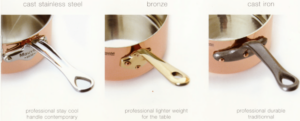 |
Status quo in 2008, left to right:
“1830”: Created and used only for Mauviel’s 2mm lines in the early 2000s and only in stainless steel. In 2017 this style was adopted across all Mauviel lines. “Classic keyhole with polygon baseplate”: In brass only, on table-grade 1.5mm pieces. I see this style on pieces dated back to the 1970s or so. “Classic teardrop”: In cast iron on extra-fort 2.5mm pieces. The hanging loop is shaped like a teardrop, hence the name. This is the style Mauviel has used since the late 19th century. |
 |
Two styles of brass handle for table-grade pieces co-existed in 2009:
Top: “Classic keyhole with polygon baseplate” Bottom: “Classic keyhole with rounded baseplate” I think the rounded baseplate style eventually replaced the polygon baseplate style but I don’t know when the changeover happened. |
 |
“Classic D-style”: Three rivets, the same design we’ve seen on French pieces since the 19th century. Shown here in 2009. |
 |
“Split baseplate”: Two rivets, in use on table-grade pieces since the 1970s. Shown here in 2012. |
 |
“M”: M for Mauviel in a circle where middle rivet would be. Used since 2015 on stick and D-style handles. |
 |
“1830”: 2 rivets, “Mauviel 1830” branding, used across all Mauviel lines since 2017. |
My review of Mauviel copper for sale at Dehillerin’s website
| Copper lined with tin | ||
|---|---|---|
| Item name in French | Common English name | Notes |
| Anything “SERVICE TABLE” | Table service grade, 1.5mm thick | Likely M’héritage 150b |
| Anything “EXTRA FORT” | Cooking grade, 2mm to 2.5mm or more | Likely M’héritage 250b |
| BAIN À POTAGE CUIVRE ÉTAMÉ AVEC COUVERCLE D18 | Soup pot | Likely M’héritage 250b. |
| BASSINE À RAGOUT CUIVRE ÉTAMÉ AVEC COUVERCLE | Stewpot with lid | Possibly M’héritage 250b. No weights provided, so I would double-check that the piece is 2.5mm or better when ordering. |
| BRAISIERE CUIVRE ÉTAMÉ AVEC COUVERCLE | Daubière | Likely M’héritage 250b. |
| MARMITE CUIVRE ÉTAMÉ AVEC COUVERCLE | Stockpot with lid | Likely M’héritage 250b. |
| PLAT À ROTIR CUIVRE ÉTAMÉ POIGNEES FIXES | Roasting pan | Likely M’héritage 250b. |
| PLAT À SAUTER CUIVRE ÉTAMÉ AVEC POIGNÉES AVEC COUVERCLE | Rondeau with lid | Possibly M’héritage 250b. Shows two-rivet (post-2015) handle. |
| POISSONNIÈRE CUIVRE ÉTAMÉ | Fish pan | Likely 1.5mm |
| POISSONNIÈRE À TRUITE CUIVRE ÉTAMÉ LONGUEUR 40 | Trout pan | At least 2mm if published weight is accurate |
| TARTE TATIN – CUIVRE ÉTAMÉ ∅32 | Tart pan | No idea about thickness. |
| TURBOTIÈRE CUIVRE ÉTAMÉ L50 | Turbot pan | Likely 1.5mm |
| Copper lined with stainless steel | ||
| Anything “CUPRINOX” and “TABLE” or “SERVICE TABLE” | Table-service grade, 1.5mm total thickness | M’tradition 150b |
| Anything “CUPRINOX M200” | Mid-grade, 2mm thickness | M’tradition 200b |
| Anything just “CUPRINOX” | Extra thick, 2.5mm thickness | M’tradition 250b |
Some quick disclaimers: This selection is from the Dehillerin website as of early 2023. I’m relying on published weights when available on the website, which may be inaccurate. I’m not covering the accessory pieces like the potato steamer, bain marie, fondue pot, etc. I’m also looking exclusively at Mauviel copper and not at other manufacturers such as De Buyer, or at Mauviel’s non-copper lines.


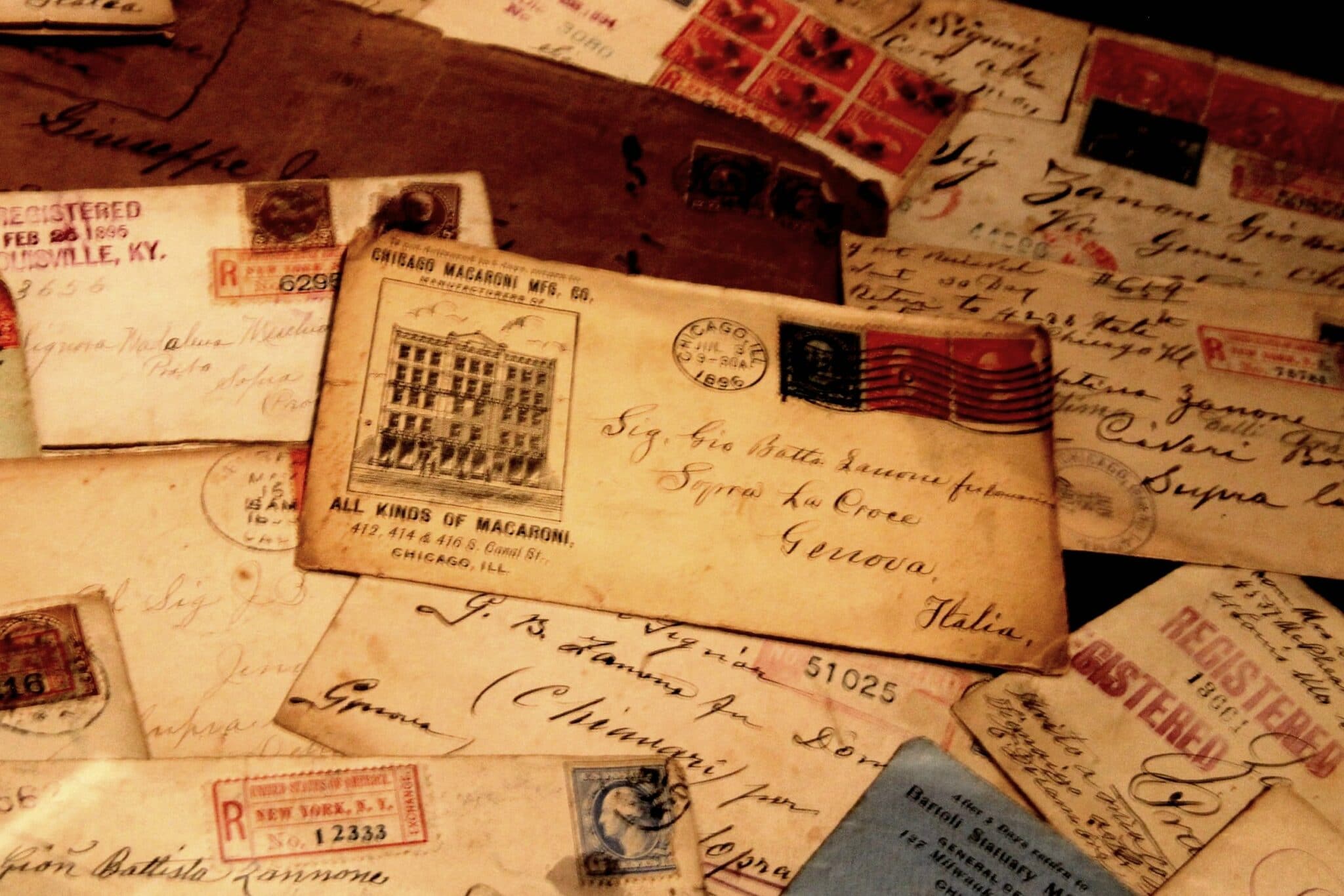
I am pleased that VFC travelled to Paris and paid a visit to what is probably the most traditional shop of kitchen items. I know some older reports about this shop, supplemented with photos that were taken about 30 years ago. But no visitor looked as closely at every detail as VFC did. Videos can also be found on the net. Nothing much seems to have changed since then. However, the shelves and drawers were better stocked back then. The shop apparently retains the nostalgic and somewhat dusty charm of old Paris. I suspect that while it still serves walk-in customers from Paris and some tourists, the more profitable sales are made online. Tinning is certainly not done in one of the rooms of the house either, but in a workshop outside. I know from a coppersmith in Germany that he only tins every few months, otherwise it is not worth the effort for him. So the commissioned pots are first kept for a longer time.
I find duck presses (with or without duck feet) less “gruesome” than smothering a duck for the dish “canard au sang” or slaughtering in general. Nevertheless, I do eat meat from time to time.
A little tip for removing unwanted reflections when taking photos: Use a polarising filter in front of the lens. These filters can be twisted so that the degree of anti-reflection can be changed. At the same time, colours are rendered more vividly. Some anglers use sunglasses with polarised lenses to reduce reflections from the surface of the water.
I’ve been to Paris a couple of times but didn’t get to Dehillerin. Of course this was before my copper craze. It seems a little underwhelming. I think Mauviel quality has certainly gone down as they don’t make heavy pieces and they don’t have the iron handles anymore.
I have some old stuff and it’s beautiful. So pretty it’s unbelievable. I know how you feel.
Hey VFC, glad you were able to make it to Dehillerin and extremely thorough roundup. One thing I should note for readers (I didn’t see it in the piece) that despite my enthusiasm when I spotted some older production copper that is on display on that peg wall and around it, I was bummed to discover that they will not sell those pieces to regular customers without some crazy negotiation. They just pull out a current production model with the M handles and stamps from the cupboards beneath that display and say it’s the same thing.
Hey Gary! That doesn’t surprise me, and that also explains why they have so much old stock on display. Thank you for contributing this info!
Thank you so much for your investigative research. I plan on visiting in September and this information will be such a time saver. Wonderful insight and perspective Sir.
Hey VFC, the homepage of Dehillerin mentions 18 et 20 rue Coquillière 75001 Paris as the address of the company. However, on the photo that you took of the store, you can read two street signs in different places with the designation 1er Arr., 51 Rue Jean-Jacques Rousseau. On Google street view, this name of the street is superimposed and you can also see the Dehillerin store. Since there are also medical offices in this building, it seems to serve several purposes today. However, when I search 18-20 rue Coquillere on Google, I again see the Dehillerin store. Apparently both street names are valid. Do you know anything more about this?
Hey Martin! The store is positioned at the junction of three streets, and the front door faces onto the shortest segment — rue Coquilliere. The offices above, by necessity, have front doors that open onto rue du Louvre or rue Jean-Jacques Rousseau.
The more I look at the photos, the more loveless and grubby I find the presentation of the products. And that in chic Paris! A connoisseur of copper pots no longer need to be convinced of the quality of these products, but less experienced customers will certainly not be won with this marketing (it can hardly be called such). 50 years without any innovation, largely the same window dressing, worn furniture, shelves and display areas at a simple DIY level and even numerous pots stuffed into plastic bags and thus hidden from customers. That’s no way to incentivize purchases! VFC did discover a few treasures with a connoisseur’s eye, but a normal visitor would overlook these special features.
If one only feeds on what previous generations have built up over decades and does not contribute anything of one’s own, the heritage is soon used up. Mauviel took a very different approach here. Even though I have reservations about some of Mauviel’s developments, the marketing is still convincing.
Why hasn’t Dehillerin set up any showroom to illustrate the important history of this company through a variety of media and by showing a few exemplary products? Is it even worthwhile to sell on the spot? If so, the rooms could certainly be made more appealing with the help of experts and the products could be presented in a more attractive way. There are far more discreet ways of securing merchandise and at the same time staging it attractively than putting it on ugly chains. One could think that the store owner does not want to give the pots away at all. In addition, loveless inscriptions or stickers that leave ugly stains on copper or tin for a long time. No customer should have access to the storage rooms.
But maybe I’m wrong, and Dehillerin customers appreciate exactly this “nonchalance” and charm of a hardware store of the 1950s. I myself am rather saddened by this situation.
Martin, I was also unimpressed with the experience, but in fairness, I visited during August which is a holiday month for Paris. There was only one storekeeper present and it is quite possible the store was in a sort of hibernation mode. Compare my experience to any of hundreds of photos on social media from others who visited — for them, the store looks brighter and busier, and the shelves and pegboard walls are full. I am coming to suspect that my visit was not at an optimal time.
But it also seems to me that Dehillerin has never been a visitor-focused store — by which I mean, they do not intend to entice shoppers with merchandising displays. I can understand this, but it’s quite different from the experience that US tourists expect. I also don’t think Dehillerin is missing out on sales because of this — I would hazard a guess that the great majority of their visitors never buy anything (or if they do, only a small trinket). A “real” cook who visits Dehillerin goes there knowing what she wants and does not need to be “sold” anything. That said, I have to wonder about the economics of this business model in the present moment. I hope Dehillerin’s website sales are sufficient to sustain the expense of maintaining this store.
I was there in January 2023 and loved the fact that the store had not been tarted up like an American mall, and yes, I am an American living in France for some years. You have to appreciate the fact that they aren’t going to sell copper cookware to someone wandering by on the street. Relatively few people cook with copper, or know how to, so those who go into the store are probably aficionados already. I’m sorry you found it sad, I was quite charmed.
bonnie in provence
Thank you for the comment, Bonnie — yours is a welcome perspective and counterweight to my one-time experience.
I’m excited that you made your pilgrimage, VFC!! And I appreciate your honest review! I haven’t been yet, but I’m always interested in reading articles and seeing pictures as Dehillerin is on my bucket list as well. We don’t have comparable retail stores in the US, other than maybe very large restaurant warehouses, so my guess is that, despite what we know about it’s set up, it’s a bit of a culture shock. Also, since we’re very passionate about our copper, the famed Dehillerin (at least for me) will be more of emotional pilgrimage, so I anticipate being a bit underwhelmed as well. I tend to build up an idea of something prior to experiencing it and have to adjust my expectations on site, but I don’t think that’s too uncommon. That said, as you mention, the store survived history while many haven’t, and it has many tales to tell. Not to mention it played a major role in the copper cookware that we collect and the history of copper cookware in cuisine, so I agree, Dehillerin deserves the respect and admiration gained in its long-famed title. When I finally visit I anticipate wandering the aisles and thinking about how Julia Child did the same, while simultaneously trying to find tin lined copper among stainless steel, and I’ll probably come home with knives and whisks :-P, but that’ll be okay. It’s a gift and a blessing to be there and appreciate its history, which makes it every bit as wonderful as it has always been :). I’m so happy that you were able to experience that and enjoy such an important and historical treasure!!
Only now I came across a 32-page booklet in Dehillerin`s current online catalog, published to mark the company`s 200th anniversary in 2020. It summarizes the history of the house, supplemented by pictures from the company`s own archive. The text is in French. It costs only €5 + shipping.
VFC, did you buy the brochure when you visited the store or earlier? Is it worth ordering?
Looks like my kitchen. Did you go to flea markets to search for copper? There are online sellers in France that do just that. You were there. Did you find any new pieces?
VFC, thank you very much for the tour of this historic culinary store. I enjoyed seeing some of their copper cookware displays but was a bit put off by the vision of plastic wrapped and chained copperware. My last order from Dehillerin in 2020 was a 32 cm rondeau which turned out to be made from 3.5 mm thick copper. I hope they are still offering pans of this quality. Did you happen to buy something while you were there? Perhaps even one of their fine aprons?
Good day to all,
we were at Dehillerin two months ago. Two weeks we were on the road – Versailles (which is not really worth it), once again the beautiful Loire Valley, Bordeaux and Saint-Émilion, later back home via Lyon. Dehillerin, along with the great Saint-Ouen flea and antique market at the Porte de Clignancourt, was to be a first highlight of this tour.
It was an ambivalent experience and we left somewhat perplexed after about an hour. It’s a wonderfully nostalgic store, just as Bonnie writes in her commentary, and our expectations of just NOT coming to a thoroughly styled department store were completely confirmed. This is exactly how we expected it! By the way, when we were there, there were enough staff on site who were a bit dismissive at first – pretty sure because they often have to experience that people only enter the store to look, but not to buy.
We were actually planning to buy a matching lid for two pots here: First for a 26 cm Rondeau with brass handles, probably Mauviel, second for a 16 cm Casserole with cast iron handle, also Mauviel. I immediately looked at the seller here that he was embarrassed to say that no more 16 or 26 cm diameter pots are made at all. With cast iron handles generally not. I found that quite disappointing, but is not the fault of Dehillerin, but the manufacturer.
We did end up buying a nice carbon steel chef’s knife and the beautiful green kitchen apron with the rooster.
This is where it got interesting in terms of the effectiveness of the store:
We gave the first seller the knife we wanted to buy. He then wrote its item number on a sales block. With this note, we went to pay the seller number two, who sat behind a glass pane in the office. After paying, we went to salesman number one, who confirmed the payment and handed the knife with the receipt to salesman number three. He looked for a cardboard cut guard for the knife blade, shortened it with scissors to the appropriate length and handed it over to us.
Personnel economy looks different!
The fact that in the basement many of the goods lie in their packaging in their compartments also contributes to the great charm of this store. Anyone who actually wants to shop here knows what they want.
Conclusion: Great store with a great past with fantastic products at the time – today, unfortunately, only a reminder of times long gone in terms of copper technology.
Gerhard, your experience aligns with mine. It was wonderful to be in the store, and I was grateful for the opportunity to stand in the aisles where so many have visited before. But I was left feeling that for those of us who consider Dehillerin to be a resource for French copper, that era is in the past.